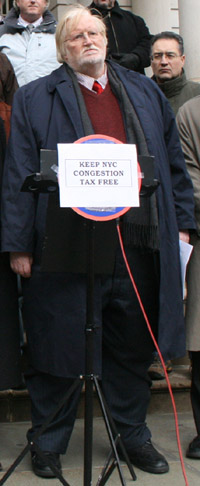Responses to $354 Million Federal Congestion Pricing Grant
 Here are two initial responses to this morning’s news that the US DOT will grant New York City $354 million to implement Mayor Bloomberg’s congestion pricing plan:
Here are two initial responses to this morning’s news that the US DOT will grant New York City $354 million to implement Mayor Bloomberg’s congestion pricing plan:
Walter McCaffrey, right, a former city councilman from Queens who has been coordinating opposition to the mayor’s plan on behalf of the Queens Chamber of Commerce, The Automobile Club of New York and parking industry interests, said in a statement:
If the goal truly is to reduce traffic, the city has a moral and legal obligation to seek any and all alternatives before adding a new tax scheme to overburdened New Yorkers. Further, the plan foresees less than an 8 percent improvement in traffic density, with the bulk of the federal funding earmarked for the city to spend on other priorities. The fact remains that the overall congestion tax and vehicle surveillance plan still can – and should – be derailed by the various legislatures if its proponents fail to prove the plan will not cause our citizens, especially those so vigorously opposed in the outer boroughs, an onerous expense and disruption. At all times, the public’s best interest should be in the driver’s seat, and we will keep our hazard lights on to continue warning all New Yorkers to the problems ahead.
Kathryn S. Wylde is the president of the Partnership for New York City, a leading member of the The Campaign for New York’s Future, a coalition of more than 150 civic, business,
environmental, labor, community and public health organizations who support congestion pricing. Wylde said in a statement:
In selecting New York City for the Urban Partners Program, the federal Department of Transportation has allowed us to meet the threshold criteria established by recent state legislation for implementation of a comprehensive program to reduce traffic congestion and improve mass transit in the region. The Partnership has documented the high cost of excess traffic, which results in losses of more than $13 billion and 50,000 jobs each year from our regional economy. Federal funding provides the carrot that will help pay for new buses, faster subways and the other measures required to incentivize people to get out of their cars and on to public transportation. This is a tremendous breakthrough in the struggle to achieve a more efficient, mobile city.





